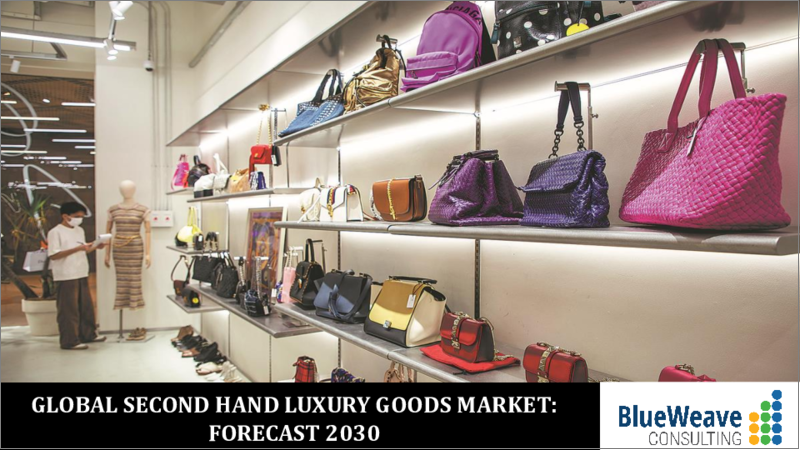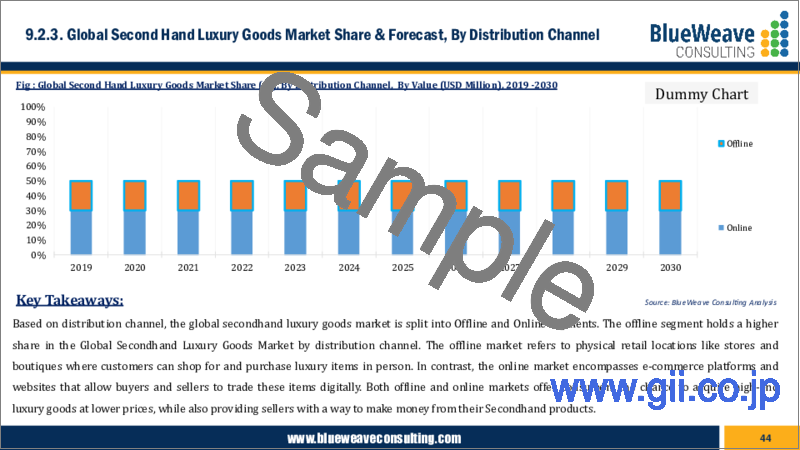|
|
市場調査レポート
商品コード
1483725
中古高級品市場- 世界の規模、シェア、動向分析、機会、予測レポート、2019-2030年Secondhand Luxury Goods Market - Global Size, Share, Trend Analysis, Opportunity and Forecast Report, 2019-2030, Segmented By Product Type; By Demography; By Distribution Channel; By Region |
||||||
|
|||||||
| 中古高級品市場- 世界の規模、シェア、動向分析、機会、予測レポート、2019-2030年 |
|
出版日: 2024年05月13日
発行: Blueweave Consulting
ページ情報: 英文 400 Pages
納期: 2~3営業日
|
全表示
- 概要
- 目次
中古高級品の世界市場規模がCAGR 9.32%で急成長、2030年には502億2,000万米ドルに達する見込み
世界の中古高級品市場は、可処分所得の増加や高級品への憧れ、消費者の嗜好の変化、オンラインプラットフォームの成長、ブランドとのコラボレーションなどにより活況を呈しています。
戦略コンサルティング・市場調査の大手BlueWeave Consultingは最近の調査で、2023年の世界の中古高級品市場規模を361億2,000万米ドルと推定しました。2024年から2030年までの予測期間中、BlueWeaveは世界の中古高級品市場規模がCAGR 9.32%で拡大し、2030年には502億2,000万米ドルに達すると予測しています。世界の中古高級品市場は、持続可能性に対する意識の高まり、製品の値ごろ感、ユニークなアイテムへの需要の高まり、オンライン・プラットフォーム経由でのアクセスの容易さ、ソーシャルメディアの役割の拡大、所有と消費に対する消費者の態度の変化などに後押しされています。また、オンライン・プラットフォームや再販市場によって、中古の高級品がより身近になったことも市場を後押ししています。消費者が持続可能性を重視するようになると、環境への影響を最小限に抑えるために中古の高級品に目を向けるようになります。予算重視のバイヤーは、この市場で低価格のハイエンドブランドを見つけ、特に価値と持続可能性を優先するミレニアル世代とZ世代にアピールしています。また、RealRealとグッチのコラボレーションのように、高級ファッションの循環を促進する再販プラットフォームと高級ブランドとのパートナーシップも、この業界に利益をもたらしています。こうした動向は、中古の高級品が広く受け入れられ、業界全体がより持続可能な慣行へとシフトしていることを反映しています。
機会- 持続可能性への注目の高まり
消費者が持続可能なショッピングをより意識するようになり、中古高級品の需要が高まっています。多くの人が環境への影響を減らすために中古の高級品を選んでいます。中古品を購入することで、消費者は商品の寿命を延ばし、新品の製造や発送に伴う二酸化炭素排出量を削減することができます。オックスファムの最近の調査によると、英国のすべての成人が新品の衣類の半分を中古で購入した場合、地球を17,000回以上周回する飛行機に相当する125億キログラムの二酸化炭素排出量を削減できるといいます。この調査は、オックスファムが毎年行っている"Second Hand September "キャンペーンの一環として発表されたもので、ウェールズの人々に中古品の購入や不要になった物の寄付を呼びかけ、持続可能性を促進することを目的としています。
地政学的緊張が世界の中古高級品市場に与える影響
地政学的緊張は世界の中古高級品市場に多面的な影響を及ぼします。国際紛争に起因する貿易制限や関税は、国境を越えた高級品の流れを混乱させ、サプライチェーンや市場アクセスに影響を及ぼす可能性があります。その結果、消費者のコストが上昇し、中古高級品の入手性が低下する可能性があります。また、政情不安は消費マインドに影響を与え、高級品への支出を減少させる可能性があります。さらに、制裁措置やその他の地政学的措置により、特定のブランドへのアクセスが制限され、再販市場に影響を及ぼす可能性もあります。その結果、世界の中古高級品市場は、安定と成長を維持するために、変化する地政学的状況に適応しなければならないです。
世界の中古高級品市場
セグメント別情報
中古高級品の世界市場- 流通チャネル別
流通チャネル別に見ると、世界の中古高級品市場はオフラインとオンラインに分けられます。中古高級品の世界市場において、流通チャネル別ではオフラインセグメントが高いシェアを占めています。オフライン市場とは、店舗やブティックのような物理的な小売拠点を指し、顧客はそこで高級品を直接購入することができます。一方、オンライン市場とは、eコマース・プラットフォームやウェブサイトを指し、買い手と売り手がデジタル上で高級品を取引することを可能にします。オフライン市場もオンライン市場も、消費者にハイエンドの高級品を低価格で手に入れるチャンスを提供すると同時に、売り手には中古品から収益を上げる方法を提供しています。
世界の中古高級品市場-地域別
世界の中古高級品市場に関する詳細な調査レポートは、5地域にわたる主要国の市場をカバーしています:北米、欧州、アジア太平洋、ラテンアメリカ、中東アフリカです。欧州が市場を独占しており、予測期間中もその優位性を維持すると予想されます。これは主に、高級ファッションの歴史が深く根付いていることと、欧州人の間で商品を再販することの経済的メリットが広く認識されていることによる。その要因としては、急速な都市化、eコマースセクターの隆盛、ファッションアパレルから化粧品に至るまで様々な高級小売ブランドの存在感の高まりなどが挙げられます。欧州では、フランスが中古高級品の圧倒的な市場として際立っているが、これは高所得人口が多いこと、中古高級品への需要が高まっていること、フランスを拠点とする高級ブランドがオンライン再販プラットフォームと提携し、中古高級品の売買を促進する傾向が強まっていることによる。
競合情勢
世界の中古高級品市場は細分化されており、多数の企業が市場に参入しています。世界の中古高級品市場を独占している主な企業は、Fashionphile Group LLC、Fendi、Garderobe、Inseller、Luxepolis、Luxury Closet, Inc.、So Chic Boutique、The Closet、The RealReal, Inc.、Timepiece360、Vestiaire Collective、Yoogi's Closet, Inc.などです。各企業が採用する主なマーケティング戦略は、顧客リーチを拡大し、市場全体における競争力を獲得するための施設拡張、製品の多様化、提携、協力、パートナーシップ、買収です。
当レポートの詳細な分析により、成長の可能性、今後の動向、世界の中古高級品市場の統計に関する情報を提供します。また、総市場規模の予測を促進する要因も取り上げています。当レポートは、世界の中古高級品市場における最近の技術動向を業界考察とともに提供し、意思決定者が健全な戦略的意思決定を行えるよう支援することを約束します。さらに、市場の成長促進要因・課題・競争力についても分析しています。
目次
第1章 調査の枠組み
第2章 エグゼクティブサマリー
第3章 世界の中古高級品市場の洞察
- 業界バリューチェーン分析
- DROC分析
- 成長促進要因
- 可処分所得の増加と贅沢品への憧れ
- 消費者の嗜好の変化
- オンラインプラットフォームの成長
- ブランドコラボレーション
- 抑制要因
- 規制と課税
- 消費者行動の変化
- 機会
- 技術の進歩
- 持続可能性への焦点
- 新製品カテゴリーへの拡大
- 課題
- 偽造
- 標準化と規制
- 成長促進要因
- 技術の進歩/最近の開発
- 規制の枠組み
- ポーターのファイブフォース分析
第4章 世界の中古高級品市場:マーケティング戦略
第5章 世界の中古高級品市場:価格分析
第6章 世界の中古高級品市場:地域分析
- 世界の中古高級品市場、地域分析、2023年
- 世界の中古高級品市場、市場魅力度分析、2024-2030年
第7章 世界の中古高級品市場概要
- 市場規模と予測、2019-2030年
- 金額別
- 市場シェアと予測
- 製品タイプ
- ハンドバッグ
- ジュエリー&時計
- 衣類
- 革小物
- 履物
- アクセサリー
- その他
- 人口統計別
- 女性
- 男性
- ユニセックス
- 流通チャネル別
- オフライン
- オンライン
- 地域別
- 北米
- 欧州
- アジア太平洋(APAC)
- ラテンアメリカ(LATAM)
- 中東およびアフリカ(MEA)
- 製品タイプ
第8章 北米の中古高級品市場
- 市場規模と予測、2019-2030年
- 金額別
- 市場シェアと予測
- 製品別
- 人口統計別
- 流通チャネル別
- 国別
- 米国
- カナダ
第9章 欧州の中古高級品市場
- 市場規模と予測、2019-2030年
- 金額別
- 市場シェアと予測
- 製品別
- 人口統計別
- 流通チャネル別
- 国別
- ドイツ
- 英国
- イタリア
- フランス
- スペイン
- ベルギー
- ロシア
- オランダ
- その他欧州
第10章 アジア太平洋地域の中古高級品市場
- 市場規模と予測、2019-2030年
- 金額別
- 市場シェアと予測
- 製品別
- 人口統計別
- 流通チャネル別
- 国別
- 中国
- インド
- 日本
- 韓国
- オーストラリアとニュージーランド
- インドネシア
- マレーシア
- シンガポール
- ベトナム
- アジア太平洋のその他諸国
第11章 ラテンアメリカの中古高級品市場
- 市場規模と予測、2019-2030年
- 金額別
- 市場シェアと予測
- 製品別
- 人口統計別
- 流通チャネル別
- 国別
- ブラジル
- メキシコ
- アルゼンチン
- ペルー
- その他のラテンアメリカ
第12章 中東・アフリカの中古高級品市場
- 市場規模と予測、2019-2030年
- 金額別
- 市場シェアと予測
- 製品別
- 人口統計別
- 流通チャネル別
- 国別
- サウジアラビア
- アラブ首長国連邦
- カタール
- クウェート
- 南アフリカ
- ナイジェリア
- アルジェリア
- 中東・アフリカの残り
第13章 競合情勢
- 主要企業とその提供内容のリスト
- 世界の中古高級品企業市場シェア分析、2023年
- 経営パラメータによる競合ベンチマーキング
- 主要な戦略的展開(合併、買収、提携など)
第14章 地政学的緊張の高まりが世界の中古高級品市場に与える影響
第15章 企業プロファイル(会社概要、財務マトリックス、競合情勢、主要人物、主要競合、連絡先、戦略展望、 SWOT分析)
- Fashionphile Group LLC.
- Fendi
- Garderobe
- Inseller
- Luxepolis
- Luxury Closet, Inc.
- So Chic Boutique
- The Closet
- The RealReal, Inc.
- Timepiece360
- Vestiaire Collective
- Yoogi's Closet, Inc.
- その他の主要企業
第16章 主要な戦略的提言
第17章 調査手法
Global Secondhand Luxury Goods Market Size Booming at Robust CAGR of 9.32% to Touch USD 50.22 Billion by 2030
Global Secondhand Luxury Goods Market is flourishing due to the rising disposable income and aspiration for luxury goods, shifting consumer preferences, growth of online platforms, and brand collaboration.
BlueWeave Consulting, a leading strategic consulting and market research firm, in its recent study, estimated the Global Secondhand Luxury Goods Market size at USD 36.12 billion in 2023. During the forecast period between 2024 and 2030, BlueWeave expects the Global Secondhand Luxury Goods Market size to expand at a CAGR of 9.32% reaching a value of USD 50.22 billion by 2030. The Global Secondhand Luxury Goods Market is propelled by the rising awareness about sustainability, the affordability of products, a growing demand for unique items, easier access via online platforms, the expanding role of social media, and changing consumer attitudes toward ownership and consumption. The market is also buoyed by online platforms and resale markets, which have made pre-owned luxury items more accessible. As consumers focus more on sustainability, they turn to secondhand luxury to minimize their environmental impact. Budget-conscious buyers find high end brands at lower prices in this market, appealing particularly to millennials and Gen Z who prioritize value and sustainability. The industry also benefits from partnerships between resale platforms and luxury brands, such as RealReal's collaboration with Gucci, which promotes circularity in luxury fashion. These trends reflect a broader acceptance of pre-owned luxury goods and an industry-wide shift toward more sustainable practices.
Opportunity - Increasing focus on sustainability
The demand for secondhand luxury goods is rising as consumers become more conscious of sustainable shopping practices. Many people are choosing pre-owned luxury items to reduce their environmental impact. By purchasing used products, consumers help extend their lifespan, thereby reducing the carbon footprint that comes with manufacturing and shipping new items. According to a recent study by Oxfam, if every adult in the UK purchased half of their new clothes secondhand, it would cut carbon dioxide emissions by 12.5 billion kilograms-equivalent to a plane circling the globe over 17,000 times. This research was released as part of Oxfam's annual "Second Hand September" campaign, which aims to promote sustainability by encouraging people in Wales to buy secondhand goods and donate items they no longer need.
Impact of Geopolitical Tensions on Global Secondhand Luxury Goods Market
Geopolitical tensions exert a multifaceted impact on the Global Secondhand Luxury Goods Market. Trade restrictions and tariffs arising from international disputes can disrupt the flow of luxury items across borders, affecting supply chains and market access. This can lead to higher costs for consumers and reduced availability of secondhand luxury goods. Political instability may also affect consumer confidence, reducing spending on luxury items. Additionally, sanctions and other geopolitical measures can limit access to certain brands, affecting resale markets. As a result, the Global Secondhand Luxury Goods Market must adapt to changing geopolitical landscapes to maintain stability and growth.
Global Secondhand Luxury Goods Market
Segmental Information
Global Secondhand Luxury Goods Market - By Distribution Channel
Based on distribution channel, the Global Secondhand Luxury Goods Market is split into Offline and Online segments. The offline segment holds a higher share in the Global Secondhand Luxury Goods Market by distribution channel. The offline market refers to physical retail locations like stores and boutiques where customers can shop for and purchase luxury items in person. In contrast, the online market encompasses e-commerce platforms and websites that allow buyers and sellers to trade these items digitally. Both offline and online markets offer consumers the chance to acquire high-end luxury goods at lower prices, while also providing sellers with a way to make money from their secondhand products.
Global Secondhand Luxury Goods Market - By Region
The in-depth research report on the Global Secondhand Luxury Goods Market covers the market in a number of major countries across five regions: North America, Europe, Asia Pacific, Latin America, and Middle East and Africa. Europe dominates the market and is expected to maintain its dominance during the forecast period. It is primarily due to its deep-rooted history in luxury fashion and the broad awareness among Europeans of the economic benefits of re-selling goods. Contributing factors include rapid urbanization, a thriving e-commerce sector, and the growing presence of various luxury retail brands, from fashion apparel to cosmetics. Within Europe, France stands out as the dominant market for secondhand luxury, thanks to its large high-income population, increasing demand for pre-owned luxury items, and the growing trend of France-based luxury brands partnering with online resale platforms to promote the buying and selling of pre-owned luxury goods.
Competitive Landscape
The Global Secondhand Luxury Goods Market is fragmented, with numerous players serving the market. The key players dominating the Global Secondhand Luxury Goods Market include Fashionphile Group LLC, Fendi, Garderobe, Inseller, Luxepolis, Luxury Closet, Inc., So Chic Boutique, The Closet, The RealReal, Inc., Timepiece360, Vestiaire Collective, and Yoogi's Closet, Inc. The key marketing strategies adopted by the players are facility expansion, product diversification, alliances, collaborations, partnerships, and acquisitions to expand their customer reach and gain a competitive edge in the overall market.
The report's in-depth analysis provides information about growth potential, upcoming trends, and the Global Secondhand Luxury Goods Market statistics. It also highlights the factors driving forecasts of total market size. The report promises to provide recent technology trends in the Global Secondhand Luxury Goods Market along with industry insights to help decision-makers make sound strategic decisions. Furthermore, the report also analyses the growth drivers, challenges, and competitive dynamics of the market.
Table of Contents
1. Research Framework
- 1.1. Research Objective
- 1.2. Product Overview
- 1.3. Market Segmentation
2. Executive Summary
3. Global Secondhand Luxury Goods Market Insights
- 3.1. Industry Value Chain Analysis
- 3.2. DROC Analysis
- 3.2.1. Growth Drivers
- 3.2.1.1. Rising Disposable Income and Aspiration for Luxury
- 3.2.1.2. Shifting Consumer Preferences
- 3.2.1.3. Growth of Online Platforms
- 3.2.1.4. Brand Collaboration
- 3.2.2. Restraints
- 3.2.2.1. Regulation and Taxation
- 3.2.2.2. Shifting Consumer Behavior
- 3.2.3. Opportunities
- 3.2.3.1. Technological Advancements
- 3.2.3.2. Sustainability Focus
- 3.2.3.3. Expansion into New Product Categories
- 3.2.4. Challenges
- 3.2.4.1. Counterfeiting
- 3.2.4.2. Standardization and Regulations
- 3.2.1. Growth Drivers
- 3.3. Technological Advancements/Recent Developments
- 3.4. Regulatory Framework
- 3.5. Porter's Five Forces Analysis
- 3.5.1. Bargaining Power of Suppliers
- 3.5.2. Bargaining Power of Buyers
- 3.5.3. Threat of New Entrants
- 3.5.4. Threat of Substitutes
- 3.5.5. Intensity of Rivalry
4. Global Secondhand Luxury Goods Market: Marketing Strategies
5. Global Secondhand Luxury Goods Market: Pricing Analysis
6. Global Secondhand Luxury Goods Market: Geographical Analysis
- 6.1. Global Secondhand Luxury Goods Market, Geographical Analysis, 2023
- 6.2. Global Secondhand Luxury Goods Market, Market Attractiveness Analysis, 2024-2030
7. Global Secondhand Luxury Goods Market Overview
- 7.1. Market Size & Forecast, 2019-2030
- 7.1.1. By Value (USD Billion)
- 7.2. Market Share & Forecast
- 7.2.1. By Product Type
- 7.2.1.1. Handbags
- 7.2.1.2. Jewelry & Watches
- 7.2.1.3. Clothing
- 7.2.1.4. Small Leather Goods
- 7.2.1.5. Footwear
- 7.2.1.6. Accessories
- 7.2.1.7. Others
- 7.2.2. By Demography
- 7.2.2.1. Women
- 7.2.2.2. Men
- 7.2.2.3. Unisex
- 7.2.3. By Distribution Channel
- 7.2.3.1. Offline
- 7.2.3.2. Online
- 7.2.4. By Region
- 7.2.4.1. North America
- 7.2.4.2. Europe
- 7.2.4.3. Asia Pacific (APAC)
- 7.2.4.4. Latin America (LATAM)
- 7.2.4.5. Middle East and Africa (MEA)
- 7.2.1. By Product Type
8. North America Secondhand Luxury Goods Market
- 8.1. Market Size & Forecast, 2019-2030
- 8.1.1. By Value (USD Billion)
- 8.2. Market Share & Forecast
- 8.2.1. By Product
- 8.2.2. By Demography
- 8.2.3. By Distribution Channel
- 8.2.4. By Country
- 8.2.4.1. United States
- 8.2.4.1.1. By Product
- 8.2.4.1.2. By Demography
- 8.2.4.1.3. By Distribution Channel
- 8.2.4.2. Canada
- 8.2.4.2.1. By Product
- 8.2.4.2.2. By Demography
- 8.2.4.2.3. By Distribution Channel
9. Europe Secondhand Luxury Goods Market
- 9.1. Market Size & Forecast, 2019-2030
- 9.1.1. By Value (USD Billion)
- 9.2. Market Share & Forecast
- 9.2.1. By Product
- 9.2.2. By Demography
- 9.2.3. By Distribution Channel
- 9.2.4. By Country
- 9.2.4.1. Germany
- 9.2.4.1.1. By Product
- 9.2.4.1.2. By Demography
- 9.2.4.1.3. By Distribution Channel
- 9.2.4.2. United Kingdom
- 9.2.4.2.1. By Product
- 9.2.4.2.2. By Demography
- 9.2.4.2.3. By Distribution Channel
- 9.2.4.3. Italy
- 9.2.4.3.1. By Product
- 9.2.4.3.2. By Demography
- 9.2.4.3.3. By Distribution Channel
- 9.2.4.4. France
- 9.2.4.4.1. By Product
- 9.2.4.4.2. By Demography
- 9.2.4.4.3. By Distribution Channel
- 9.2.4.5. Spain
- 9.2.4.5.1. By Product
- 9.2.4.5.2. By Demography
- 9.2.4.5.3. By Distribution Channel
- 9.2.4.6. Belgium
- 9.2.4.6.1. By Product
- 9.2.4.6.2. By Demography
- 9.2.4.6.3. By Distribution Channel
- 9.2.4.7. Russia
- 9.2.4.7.1. By Product
- 9.2.4.7.2. By Demography
- 9.2.4.7.3. By Distribution Channel
- 9.2.4.8. The Netherlands
- 9.2.4.8.1. By Product
- 9.2.4.8.2. By Demography
- 9.2.4.8.3. By Distribution Channel
- 9.2.4.9. Rest of Europe
- 9.2.4.9.1. By Product
- 9.2.4.9.2. By Demography
- 9.2.4.9.3. By Distribution Channel
10. Asia Pacific Secondhand Luxury Goods Market
- 10.1. Market Size & Forecast, 2019-2030
- 10.1.1. By Value (USD Billion)
- 10.2. Market Share & Forecast
- 10.2.1. By Product
- 10.2.2. By Demography
- 10.2.3. By Distribution Channel
- 10.2.4. By Country
- 10.2.4.1. China
- 10.2.4.1.1. By Product
- 10.2.4.1.2. By Demography
- 10.2.4.1.3. By Distribution Channel
- 10.2.4.2. India
- 10.2.4.2.1. By Product
- 10.2.4.2.2. By Demography
- 10.2.4.2.3. By Distribution Channel
- 10.2.4.3. Japan
- 10.2.4.3.1. By Product
- 10.2.4.3.2. By Demography
- 10.2.4.3.3. By Distribution Channel
- 10.2.4.4. South Korea
- 10.2.4.4.1. By Product
- 10.2.4.4.2. By Demography
- 10.2.4.4.3. By Distribution Channel
- 10.2.4.5. Australia & New Zealand
- 10.2.4.5.1. By Product
- 10.2.4.5.2. By Demography
- 10.2.4.5.3. By Distribution Channel
- 10.2.4.6. Indonesia
- 10.2.4.6.1. By Product
- 10.2.4.6.2. By Demography
- 10.2.4.6.3. By Distribution Channel
- 10.2.4.7. Malaysia
- 10.2.4.7.1. By Product
- 10.2.4.7.2. By Demography
- 10.2.4.7.3. By Distribution Channel
- 10.2.4.8. Singapore
- 10.2.4.8.1. By Product
- 10.2.4.8.2. By Demography
- 10.2.4.8.3. By Distribution Channel
- 10.2.4.9. Vietnam
- 10.2.4.9.1. By Product
- 10.2.4.9.2. By Demography
- 10.2.4.9.3. By Distribution Channel
- 10.2.4.10. Rest of APAC
- 10.2.4.10.1. By Product
- 10.2.4.10.2. By Demography
- 10.2.4.10.3. By Distribution Channel
11. Latin America Secondhand Luxury Goods Market
- 11.1. Market Size & Forecast, 2019-2030
- 11.1.1. By Value (USD Billion)
- 11.2. Market Share & Forecast
- 11.2.1. By Product
- 11.2.2. By Demography
- 11.2.3. By Distribution Channel
- 11.2.4. By Country
- 11.2.4.1. Brazil
- 11.2.4.1.1. By Product
- 11.2.4.1.2. By Demography
- 11.2.4.1.3. By Distribution Channel
- 11.2.4.2. Mexico
- 11.2.4.2.1. By Product
- 11.2.4.2.2. By Demography
- 11.2.4.2.3. By Distribution Channel
- 11.2.4.3. Argentina
- 11.2.4.3.1. By Product
- 11.2.4.3.2. By Demography
- 11.2.4.3.3. By Distribution Channel
- 11.2.4.4. Peru
- 11.2.4.4.1. By Product
- 11.2.4.4.2. By Demography
- 11.2.4.4.3. By Distribution Channel
- 11.2.4.5. Rest of LATAM
- 11.2.4.5.1. By Product
- 11.2.4.5.2. By Demography
- 11.2.4.5.3. By Distribution Channel
12. Middle East & Africa Secondhand Luxury Goods Market
- 12.1. Market Size & Forecast, 2019-2030
- 12.1.1. By Value (USD Billion)
- 12.2. Market Share & Forecast
- 12.2.1. By Product
- 12.2.2. By Demography
- 12.2.3. By Distribution Channel
- 12.2.4. By Country
- 12.2.4.1. Saudi Arabia
- 12.2.4.1.1. By Product
- 12.2.4.1.2. By Demography
- 12.2.4.1.3. By Distribution Channel
- 12.2.4.2. UAE
- 12.2.4.2.1. By Product
- 12.2.4.2.2. By Demography
- 12.2.4.2.3. By Distribution Channel
- 12.2.4.3. Qatar
- 12.2.4.3.1. By Product
- 12.2.4.3.2. By Demography
- 12.2.4.3.3. By Distribution Channel
- 12.2.4.4. Kuwait
- 12.2.4.4.1. By Product
- 12.2.4.4.2. By Demography
- 12.2.4.4.3. By Distribution Channel
- 12.2.4.5. South Africa
- 12.2.4.5.1. By Product
- 12.2.4.5.2. By Demography
- 12.2.4.5.3. By Distribution Channel
- 12.2.4.6. Nigeria
- 12.2.4.6.1. By Product
- 12.2.4.6.2. By Demography
- 12.2.4.6.3. By Distribution Channel
- 12.2.4.7. Algeria
- 12.2.4.7.1. By Product
- 12.2.4.7.2. By Demography
- 12.2.4.7.3. By Distribution Channel
- 12.2.4.8. Rest of MEA
- 12.2.4.8.1. By Product
- 12.2.4.8.2. By Demography
- 12.2.4.8.3. By Distribution Channel
13. Competitive Landscape
- 13.1. List of Key Players and Their Offerings
- 13.2. Global Secondhand Luxury Goods Company Market Share Analysis, 2023
- 13.3. Competitive Benchmarking, By Operating Parameters
- 13.4. Key Strategic Developments (Mergers, Acquisitions, Partnerships, etc.)
14. Impact of Escalating Geopolitical Tensions on Global Secondhand Luxury Goods Market
15. Company Profiles (Company Overview, Financial Matrix, Competitive Landscape, Key Personnel, Key Competitors, Contact Address, Strategic Outlook, and SWOT Analysis)
- 15.1. Fashionphile Group LLC.
- 15.2. Fendi
- 15.3. Garderobe
- 15.4. Inseller
- 15.5. Luxepolis
- 15.6. Luxury Closet, Inc.
- 15.7. So Chic Boutique
- 15.8. The Closet
- 15.9. The RealReal, Inc.
- 15.10. Timepiece360
- 15.11. Vestiaire Collective
- 15.12. Yoogi's Closet, Inc.
- 15.13. Other Prominent Players
16. Key Strategic Recommendations
17. Research Methodology
- 17.1. Qualitative Research
- 17.1.1. Primary & Secondary Research
- 17.2. Quantitative Research
- 17.3. Market Breakdown & Data Triangulation
- 17.3.1. Secondary Research
- 17.3.2. Primary Research
- 17.4. Breakdown of Primary Research Respondents, By Region
- 17.5. Assumptions & Limitations





